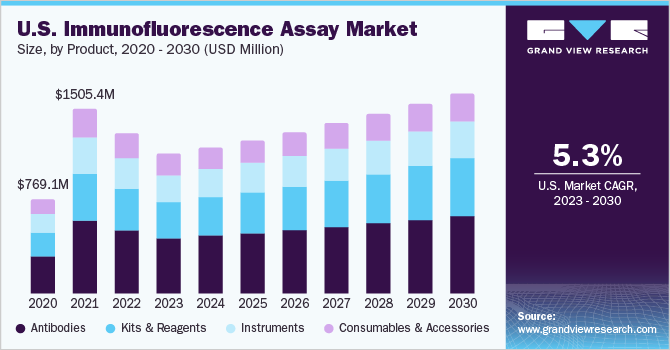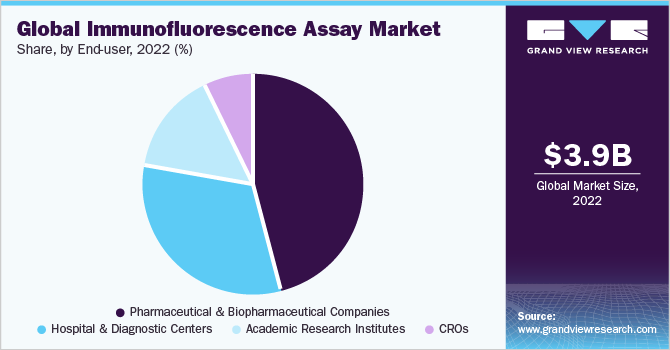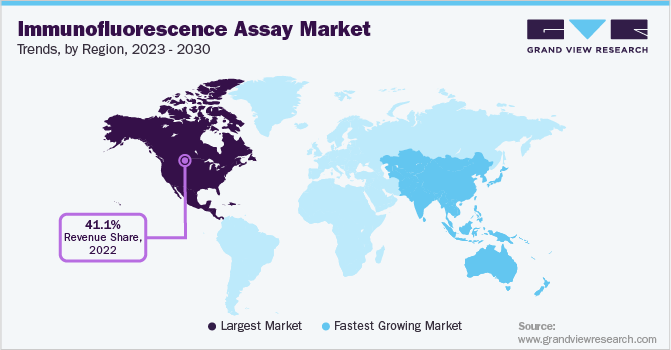- Home
- »
- Clinical Diagnostics
- »
-
Immunofluorescence Assay Market Size & Share Report, 2030GVR Report cover
![Immunofluorescence Assay Market Size, Share & Trends Report]()
Immunofluorescence Assay Market Size, Share & Trends Analysis Report By Product (Antibodies, Kits & Reagents, Instruments, Consumables & Accessories), By Type, By Application, By End-user, By Region, And Segment Forecasts, 2023 - 2030
- Report ID: GVR-4-68040-042-2
- Number of Report Pages: 150
- Format: PDF, Horizon Databook
- Historical Range: 2018 - 2021
- Forecast Period: 2023 - 2030
- Industry: Healthcare
Report Overview
The global immunofluorescence assay market size was valued at USD 3,958.6 million in 2022 and is anticipated to expand at a CAGR of 5.29% from 2023 to 2030. Immunofluorescence assay (IFA) is a test performed on biological samples to detect specific antigens in any biological sample or specimen. The technique is based on the antigen-antibody specificity. An immunofluorescence test uses a fluorescent dye that illuminates under UV light to detect a particular antigen and antibody combination. Fluorescein isothiocyanate, a dye that produces a yellow-green fluorescence, is commonly utilized in these assays. Immunofluorescence tests are also known as fluorescent antibody tests (FAT).

The COVID-19 pandemic has increased the demand for rapid testing methods such as, immunofluorescence assay for disease surveillance and management of outbreaks. Moreover, there has been an upsurge in the development of SARS-CoV-2 Ab Tests by several leading players. For instance, LumiraDx developed a microfluidic immunofluorescence assay, LumiraDx SARS-CoV-2 Ab Test to detect total antibodies to SARS-CoV-2 in serum, plasma, or blood. In addition, in August 2021, the LumiraDx SARS-CoV-2 Ab Test received emergency use authorization by FDA. Hence, the development of novel products and approvals for COVID-19 disease has positively affected the growth of the market.
One of the key factor propelling the growth of the immunofluorescence assay market globally is the rising prevalence of chronic diseases, such as different infectious diseases and non-infectious diseases (including autoimmune diseases, cancer, diabetes, and cardiovascular diseases, &). The prevalence of these diseases is increasing due to a number of reasons, such as unhealthy and sedentary lifestyles, alcoholism, smoking, and antibiotic resistance. For instance, according to the world health organization (WHO), in 2020 there were about 1 in 6 deaths or 10 million deaths due to cancer, making it one of the foremost causes of death worldwide. Thus, with the rising incidence of chronic diseases, the demand for immunofluorescence assay is likely to increase in the coming years.
Furthermore, emerging applications of immunofluorescence assay in numerous areas are projected to boost the market during the study period. Immunofluorescence assay can be used on cells or tissue to determine the presence of various biological molecules, which also includes carbohydrates and proteins among others. They are also employed in molecular biology to visualize cytoskeletons such as intermediate filaments. The technique is additionally utilized in conjunction with other non-antibody methods of fluorescence staining. For instance, DNA labeling can be performed using a fluorescent strain DAPI. Such, capabilities are likely to boost the market over the forecast period.
Moreover, operating players in the market are developing sophisticated technologies to meet the rising demand and capture untapped opportunities in the immunofluorescence assay market. For instance, in March 2021, EUROIMMUN, a subsidiary of PerkinElmer, Inc. introduced a novel ultrafast automated immunofluorescence microscope EUROPatternTM Microscope Live (EPML) compact immunofluorescence microscope. The novel microscope is coupled with well-established software EUROLabOffice 4.0 to obtain automated immunofluorescence image acquisition, titer estimation, pattern recognition, and as well as modern diagnostics at the screen. Thus, technological advancements of instruments associated with immunofluorescence assay are anticipated to drive the market growth.
Product Insights
The antibodies segment dominated the market and accounted for the largest revenue share of 39.13% in 2022. The immunofluorescence technique relies on the specific antibodies to label a specific target antigen by using fluorescent dyes. For instance, the direct immunofluorescence utilizes an antibody that is conjugated to a fluorescent dye. The antibody detects the target molecule and binds to it. The fluroscence can be visualized using a confocal or fluorescence microscope. Few commercially available antibodies by Thermo Fisher Scientific, Inc. includeAPOE Recombinant Rabbit Monoclonal Antibody, c-Myc Monoclonal Antibody, and Goat anti-Human IgG Fc Cross-Adsorbed Secondary Antibody, HRP, among others. Hence, the prominent use of antibodies in the immunofluorescence technique is driving the segment growth.
The kits and reagents segment is projected to grow at the fastest CAGR of 6.96% over the forecast period. The immunofluorescence kits are user friendly, cost effective, with high specificity and sensitivity. Moreover, several players in the market are offering kits specially designed for immunofluorescence detection on formalin-fixed paraffin embedded cell smears, tissues, and cryostat sections. For instance, Medaysis Company offersMedaFluo Non-biotin Immunofluorescence Detection Kits for detection of frozen and paraffin tissue sections. Such capabilities are likely to boost the segment over the forecast period.
Type Insights
The indirect immunofluorescence segment dominated the market and accounted for the largest revenue share of 65.18% in 2022 and is anticipated to grow at the fastest CAGR of 5.65% during the forecast years. The technique uses primary and secondary antibodies. The primary antibody identifies the target molecule and bids to it, further the secondary antibody conjugated with a fluroscent dye detects and binds to the primary antibody and proximally localises the target for microscopic detection. The technique is more complex compared to the direct method. However, the indirect immunoflurocence is more sensitive and single fluorochrome-labeled id used for detecting many Ag-Ab interactions.
The key applications of the technique include detection of specific antibodies for diagnosis of amoebiasis, syphilis, toxoplasmosis, leptospirosis, and other diseases. In addition, it can be used in the detection of autoantibodies, which cause auto immune disorders. Furthermore, advantages of indirect immunofluorescence such as tends to be less expensive, immunofluorescence, better amplification of the signal, flexibility, and provides a top-notch image. These qualities and applications of IFA are expected to boost the segment in the near future.
Application Insights
The infectious disease segment dominated the market and accounted for the largest revenue bgrshare of 59.71% in 2022. This can be attributed to the widespread adoption of immunofluorescence techniques for the study and diagnosis of infectious diseases such as COVID-19. In addition the onset of COVID-19 and growing awareness for early diagnosis, are the major factor driving growth of the IFA market during the study period. The new episode of the COVID-19 pandemic has further increased the demand for IFA based COVID-19 kits and instruments to control the spread of the COVID..
The autoimmune diseases segment is expected to expand at the fastest CAGR of 6.57% during 2023-2030. Immunofluorescence assays are vital tool for diagnosing autoimmune diseases, since they recognize autoantibodies. The antinuclear antibody immunofluorescence assay with specific antibody lead to early diagnosis and treatment of potentially devastating diseases. The technique uses humor tumor cell line or various tissue section as an antigenic source for diagnosis of autoimmune diseases. Thus, the growing incidence of autoimmune diseases such as rheumatoid arthritis, lupus, and multiple sclerosis among others are expected to fuel the segment growth in the near future.
End-user Insights
The pharmaceutical & biopharmaceutical companies segment dominated the market and accounted for the largest revenue share of 45.49% in 2022. The segment is expected grow at a rapid pace during 2023-2030. These companies are involved in strategic initiatives, such as mergers & acquisitions, product development, product approvals & launches, and expansion of global operations. For instance, in January 2021, LumiraDx received multinational approval for its SARS-CoV-2 Antigen Test. The immunofluorescence assay is designed for quick and accurate detection of the SARS-CoV-2 antigen in nasopharyngeal or nasal swab specimens.

Furthermore, emerging players in the market are undertaking several partnerships to enhance their offerings in IFAs. For instance,Agilent Technologies, Inc. and Akoya Biosciences, Inc. entered into a strategic partnership to develop immunofluorescent and chromogenic multiplex assays that include spatial analysis for biopharmaceuticals developing precision cancer therapeutics. Similarly, in 2022, Nucleai and Propath UK entered into a partnership to develop and authenticate immunofluorescence panel focused on protein targets relevant to immuno-oncology for pharmaceutical and biopharmaceutical companies. Hence, such initiatives by operating players are projected to fuel the segment growth during the study period.
Regional Insights
North America region dominated the immunofluorescence market and accounted for the largest revenue share of 41.11% in 2022 due to, presence of key players, existence sophisticated healthcare infrastructure, increase in product approvals, and strong government initiatives & awareness programs to curb the spread of several diseases such as HIV/AIDS, among other factors are driving growth in this region. For instance, in December 2022, Quidel TriageTrue High-Sensitivity Troponin I Test designed by QuidelOrtho Corporation for the diagnosis of myocardial infraction received license by the Health Canada. In addition, ending the HIV Epidemic in the U.S. (EHE) is one such program launched in 2019 with the aim of ending the country’s HIV epidemic by 2030. Such, initiatives are anticipated to drive frequent and preventive testing measures that can raise the demand for immunofluorescence assays.

The Asia Pacific region is projected to grow at the fastest CAGR of 5.76% during 2023-2030 due to the emerging economies such as India and China, coupled with increasing epidemic of infectious diseasessuch as HIV, Hepatitis B & C, and tuberculosis. According to a report published by the CDC, TB is a common cause of death in India. The CDC works to enhance TB/HIV coordination to effectively diagnose & treat TB and provide preventive treatment. It supports the Revised National TB Control Programme to help curb TB by improving diagnosis, treatment, and prevention by strengthening clinical & laboratory capacity. Such initiatives in the region are expected to fuel the market.
Key Companies & Market Share Insights
The immunofluorescence assay market is growing at a rapid pace due to the various strategic initiatives adopted by key companies involved. For instance, for instance, in March 2022, Thermo Fisher Scientific, Inc. extended its strategic collaboration with Symphogen to develop innovative tools and streamlined workflows such as immunofluorescence assays for biopharma discovery and development of complex therapeutic proteins. Some of the prominent players in the global immunofluorescence market include:
-
Thermo Fisher Scientific, Inc.
-
Inova Diagnostics, Inc.
-
Bio-Rad Laboratories, Inc.
-
Abcam plc
-
PerkinElmer Inc.
-
Merck KGaA
-
Cell Signaling Technology, Inc.
-
Medipan GmbH
-
Sino Biological, Inc.
-
Danaher Corporation
Immunofluorescence Assay Market Report Scope
Report Attribute
Details
Market size value in 2023
USD 3,453.5 million
Revenue forecast in 2030
USD 4.95 billion
Growth rate
CAGR of 5.29% from 2023 to 2030
Base year for estimation
2022
Historical data
2018 - 2021
Forecast period
2023 - 2030
Quantitative units
Revenue in USD Million and CAGR from 2023 to 2030
Report coverage
Revenue forecast, company ranking, competitive landscape, growth factors, and trends
Segments covered
Product, type, application, end-user, region
Regional scope
North America; Europe; Asia Pacific; Latin America; MEA
Country scope
U.S.; Canada; U.K.; Germany; France; Italy; Spain; Denmark; Sweden; Norway; Japan; China; India; South Korea; Australia; Thailand; Brazil; Mexico; Argentina; South Africa; Saudi Arabia; UAE; Kuwait
Key companies profiled
Thermo Fisher Scientific Inc.; Inova Diagnostics, Inc.; Bio-Rad Laboratories, Inc.; Abcam plc; PerkinElmer Inc.; Merck KGaA; Cell Signaling Technology, Inc.; Medipan GmbH; Sino Biological, Inc.; Danaher Corporation
Customization scope
Free report customization (equivalent up to 8 analyst’s working days) with purchase. Addition or alteration to country, regional & segment scope.
Pricing and purchase options
Avail customized purchase options to meet your exact research needs. Explore purchase options
Global Immunofluorescence Assay Market Segmentation
This report forecasts revenue growth and provides an analysis on the latest trends in each of the sub-segments from 2018 to 2030. For the purpose of this report, Grand View Research has segmented the global immunofluorescence assay market based on product, type, application, end-user, and region
-
Product Outlook (Revenue, USD Million, 2018 - 2030)
-
Antibodies
-
Kits and reagents
-
Instruments
-
Consumables and Accessories
-
-
Type Outlook (Revenue, USD Million, 2018 - 2030)
-
Indirect Immunofluorescence
-
Direct Immunofluorescence
-
-
Application Outlook (Revenue, USD Million, 2018 - 2030)
-
Cancer
-
Infectious Diseases
-
Autoimmune Diseases
-
Others
-
-
End-user Outlook (Revenue, USD Million, 2018 - 2030)
-
Academic Research Institutes
-
Pharmaceutical & Biopharmaceutical Companies
-
CROs
-
Hospital and Diagnostic Centers
-
-
Regional Outlook (Revenue, USD Million, 2018 - 2030)
-
North America
-
U.S.
-
Canada
-
-
Europe
-
U.K.
-
Germany
-
France
-
Italy
-
Spain
-
Denmark
-
Sweden
-
Norway
-
-
Asia Pacific
-
Japan
-
China
-
India
-
South Korea
-
Thailand
-
Australia
-
-
Latin America
-
Brazil
-
Mexico
-
Argentina
-
-
Middle East and Africa (MEA)
-
South Africa
-
Saudi Arabia
-
UAE
-
Kuwait
-
-
Frequently Asked Questions About This Report
b. The global immunofluorescence assays market size was estimated at USD 3,958.6 million in 2022 and is expected to reach USD 3,453.5 million in 2023.
b. The global immunofluorescence assays market is expected to grow at a compound annual growth rate of 5.29% from 2023 to 2030 to reach USD 4.95 billion by 2030.
b. The indirect immunofluorescence segment dominated the global market in 2022 and captured the maximum share of the overall revenue. The large share can be attributed to the advantages associated with indirect immunofluorescence such as tends to be less expensive, immunofluorescence, better amplification of the signal, flexibility, and provides a top-notch image. These qualities and applications of IFA are expected to boost the segment in the near future.
b. Some key players operating in the vacuum blood collection tubes market include Thermo Fisher Scientific Inc., Inova Diagnostics, Inc., Bio-Rad Laboratories, Inc., Abcam plc, PerkinElmer Inc. and Merck KGaA
b. The increasing prevalence of chronic and infectious diseases, significant applications of immunofluorescence assay in several areas, and technological advancements in techniques and associated instruments are key factors driving the market growth. Furthermore, COVID-19 pandemic has boosted the adoption of immunofluorescence assays due to a sharp rise in the demand for rapid, point-of-care testing of the disease
Share this report with your colleague or friend.
![gvr icn]()
NEED A CUSTOM REPORT?
We can customize every report - free of charge - including purchasing stand-alone sections or country-level reports, as well as offer affordable discounts for start-ups & universities. Contact us now
![Certified Icon]()
We are GDPR and CCPA compliant! Your transaction & personal information is safe and secure. For more details, please read our privacy policy.
We are committed towards customer satisfaction, and quality service.
"The quality of research they have done for us has been excellent."





